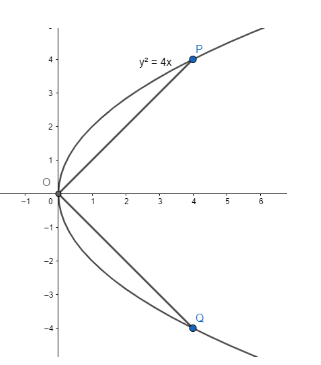
Through the vertex of the parabola\[{{y}^{2}}=4x\]chords\[OP\]and\[OQ\]are drawn at
right angles to one another. The locus of middle point of\[PQ\]is
(a) \[{{y}^{2}}=x+8\]
(b) \[{{y}^{2}}=-2x+8\]
(c) \[{{y}^{2}}=2x-8\]
(d) \[{{y}^{2}}=x-8\]
Answer
216.6k+ views
Hint: To find the locus of the middle point of two points on the parabola, write the points in parametric form and then find the middle point of the points. Use the fact that the product of slope of any two perpendicular lines is\[-1\].
We have the parabola\[{{y}^{2}}=4x\]. We want to find the locus of middle point of two
points on the parabola such that the chords joining two points of the parabola to its vertex are
perpendicular to each other.
We know that the vertex of parabola of the form\[{{y}^{2}}=4ax\]is\[\left( 0,0 \right)\].
Thus, we have\[\left( 0,0 \right)\]as the vertex of the parabola\[{{y}^{2}}=4x\].

To find the locus of middle point of\[PQ\], let’s write the points in parametric form.
We know that any point of the parabola\[{{y}^{2}}=4ax\] is of the form\[\left( a{{t}^{2}},2at \right)\].
Substituting\[a=1\]in the above equation, we have the two points on our parabola as\[P\left(
{{t}_{1}} \right)=\left( t_{1}^{2},2{{t}_{1}} \right)\]and\[Q\left( {{t}_{2}} \right)=\left(
t_{2}^{2},2{{t}_{2}} \right)\].
We know that the equation of any line passing through origin is of the form\[y=mx\].
Let’s assume that the equation of line joining origin and\[P\left( {{t}_{1}} \right)=\left(
t_{1}^{2},2{{t}_{1}} \right)\]is of the form\[y={{m}_{1}}x\].
Substituting the point\[P\left( {{t}_{1}} \right)=\left( t_{1}^{2},2{{t}_{1}} \right)\]in the equation of
line, we have\[2{{t}_{1}}={{m}_{1}}t_{1}^{2}\].
Thus, we have\[{{m}_{1}}=\dfrac{2}{{{t}_{1}}}\]. \[...\left( 1 \right)\]
Let’s assume that the equation of line joining origin and\[Q\left( {{t}_{2}} \right)=\left(
t_{2}^{2},2{{t}_{2}} \right)\]is of the form\[y={{m}_{2}}x\].
Substituting the point\[Q\left( {{t}_{2}} \right)=\left( t_{2}^{2},2{{t}_{2}} \right)\]in the equation of
line, we have\[2{{t}_{2}}={{m}_{2}}t_{2}^{2}\].
Thus, we have\[{{m}_{2}}=\dfrac{2}{{{t}_{2}}}\]. \[...\left( 2 \right)\]
We know that the two chords passing through\[P\]and\[Q\]are perpendicular, so the product of
their slope is\[-1\].
Using equation\[\left( 1 \right)\]and\[\left( 2 \right)\], we have\[{{m}_{1}}{{m}_{2}}=-1\].
\[\begin{align}
& \Rightarrow \dfrac{2}{{{t}_{1}}}\times \dfrac{2}{{{t}_{2}}}=-1 \\
& \Rightarrow {{t}_{1}}{{t}_{2}}=-4 \\
\end{align}\]
Thus, we can write\[{{t}_{1}}\]as\[{{t}_{1}}=\dfrac{-4}{{{t}_{2}}}\]. \[...\left( 3 \right)\]
We know that the middle point of two points of the form\[\left( {{x}_{1}},{{y}_{1}} \right)\]and\[\left(
{{x}_{2}},{{y}_{2}} \right)\]is\[\left( \dfrac{{{x}_{1}}+{{x}_{2}}}{2},\dfrac{{{y}_{1}}+{{y}_{2}}}{2} \right)\].
Substituting\[{{x}_{1}}=t_{1}^{2},{{y}_{1}}=2{{t}_{1}},{{x}_{2}}=t_{2}^{2},{{y}_{2}}=2{{t}_{2}}\]in the
above equation, we have\[\left( \dfrac{t_{1}^{2}+t_{2}^{2}}{2},\dfrac{2{{t}_{1}}+2{{t}_{2}}}{2}
\right)\]as the mid point of the points\[P\left( {{t}_{1}} \right)\]and\[Q\left( {{t}_{2}} \right)\].
Let’s assume\[x=\dfrac{t_{1}^{2}+t_{2}^{2}}{2},y=\dfrac{2{{t}_{1}}+2{{t}_{2}}}{2}\].
Substituting equation\[\left( 3 \right)\]in the above equation, we have\[x=\dfrac{{{\left( \dfrac{-
4}{{{t}_{2}}} \right)}^{2}}+t_{2}^{2}}{2},y=\dfrac{2\left( \dfrac{-4}{{{t}_{2}}} \right)+2{{t}_{2}}}{2}\].
Solving the above equation, we get\[x=\dfrac{{{\left( \dfrac{-4}{{{t}_{2}}}
\right)}^{2}}+t_{2}^{2}}{2}\]and\[y=\dfrac{-4}{{{t}_{2}}}+{{t}_{2}}\].
Squaring the second equation, we get\[{{y}^{2}}={{\left( \dfrac{-4}{{{t}_{2}}} \right)}^{2}}+t_{2}^{2}-
8\].
\[\Rightarrow {{y}^{2}}+8={{\left( \dfrac{-4}{{{t}_{2}}} \right)}^{2}}+t_{2}^{2}\]
Substituting the above equation in\[x=\dfrac{{{\left( \dfrac{-4}{{{t}_{2}}} \right)}^{2}}+t_{2}^{2}}{2}\],
we get\[x=\dfrac{{{\left( \dfrac{-4}{{{t}_{2}}} \right)}^{2}}+t_{2}^{2}}{2}=\dfrac{{{y}^{2}}+8}{2}\].
\[\Rightarrow 2x={{y}^{2}}+8\]
Hence, the correct answer is\[{{y}^{2}}=2x-8\].
Note: It’s necessary to use the fact that the two chords are perpendicular and hence, the product of their slope is\[-1\].
We have the parabola\[{{y}^{2}}=4x\]. We want to find the locus of middle point of two
points on the parabola such that the chords joining two points of the parabola to its vertex are
perpendicular to each other.
We know that the vertex of parabola of the form\[{{y}^{2}}=4ax\]is\[\left( 0,0 \right)\].
Thus, we have\[\left( 0,0 \right)\]as the vertex of the parabola\[{{y}^{2}}=4x\].

To find the locus of middle point of\[PQ\], let’s write the points in parametric form.
We know that any point of the parabola\[{{y}^{2}}=4ax\] is of the form\[\left( a{{t}^{2}},2at \right)\].
Substituting\[a=1\]in the above equation, we have the two points on our parabola as\[P\left(
{{t}_{1}} \right)=\left( t_{1}^{2},2{{t}_{1}} \right)\]and\[Q\left( {{t}_{2}} \right)=\left(
t_{2}^{2},2{{t}_{2}} \right)\].
We know that the equation of any line passing through origin is of the form\[y=mx\].
Let’s assume that the equation of line joining origin and\[P\left( {{t}_{1}} \right)=\left(
t_{1}^{2},2{{t}_{1}} \right)\]is of the form\[y={{m}_{1}}x\].
Substituting the point\[P\left( {{t}_{1}} \right)=\left( t_{1}^{2},2{{t}_{1}} \right)\]in the equation of
line, we have\[2{{t}_{1}}={{m}_{1}}t_{1}^{2}\].
Thus, we have\[{{m}_{1}}=\dfrac{2}{{{t}_{1}}}\]. \[...\left( 1 \right)\]
Let’s assume that the equation of line joining origin and\[Q\left( {{t}_{2}} \right)=\left(
t_{2}^{2},2{{t}_{2}} \right)\]is of the form\[y={{m}_{2}}x\].
Substituting the point\[Q\left( {{t}_{2}} \right)=\left( t_{2}^{2},2{{t}_{2}} \right)\]in the equation of
line, we have\[2{{t}_{2}}={{m}_{2}}t_{2}^{2}\].
Thus, we have\[{{m}_{2}}=\dfrac{2}{{{t}_{2}}}\]. \[...\left( 2 \right)\]
We know that the two chords passing through\[P\]and\[Q\]are perpendicular, so the product of
their slope is\[-1\].
Using equation\[\left( 1 \right)\]and\[\left( 2 \right)\], we have\[{{m}_{1}}{{m}_{2}}=-1\].
\[\begin{align}
& \Rightarrow \dfrac{2}{{{t}_{1}}}\times \dfrac{2}{{{t}_{2}}}=-1 \\
& \Rightarrow {{t}_{1}}{{t}_{2}}=-4 \\
\end{align}\]
Thus, we can write\[{{t}_{1}}\]as\[{{t}_{1}}=\dfrac{-4}{{{t}_{2}}}\]. \[...\left( 3 \right)\]
We know that the middle point of two points of the form\[\left( {{x}_{1}},{{y}_{1}} \right)\]and\[\left(
{{x}_{2}},{{y}_{2}} \right)\]is\[\left( \dfrac{{{x}_{1}}+{{x}_{2}}}{2},\dfrac{{{y}_{1}}+{{y}_{2}}}{2} \right)\].
Substituting\[{{x}_{1}}=t_{1}^{2},{{y}_{1}}=2{{t}_{1}},{{x}_{2}}=t_{2}^{2},{{y}_{2}}=2{{t}_{2}}\]in the
above equation, we have\[\left( \dfrac{t_{1}^{2}+t_{2}^{2}}{2},\dfrac{2{{t}_{1}}+2{{t}_{2}}}{2}
\right)\]as the mid point of the points\[P\left( {{t}_{1}} \right)\]and\[Q\left( {{t}_{2}} \right)\].
Let’s assume\[x=\dfrac{t_{1}^{2}+t_{2}^{2}}{2},y=\dfrac{2{{t}_{1}}+2{{t}_{2}}}{2}\].
Substituting equation\[\left( 3 \right)\]in the above equation, we have\[x=\dfrac{{{\left( \dfrac{-
4}{{{t}_{2}}} \right)}^{2}}+t_{2}^{2}}{2},y=\dfrac{2\left( \dfrac{-4}{{{t}_{2}}} \right)+2{{t}_{2}}}{2}\].
Solving the above equation, we get\[x=\dfrac{{{\left( \dfrac{-4}{{{t}_{2}}}
\right)}^{2}}+t_{2}^{2}}{2}\]and\[y=\dfrac{-4}{{{t}_{2}}}+{{t}_{2}}\].
Squaring the second equation, we get\[{{y}^{2}}={{\left( \dfrac{-4}{{{t}_{2}}} \right)}^{2}}+t_{2}^{2}-
8\].
\[\Rightarrow {{y}^{2}}+8={{\left( \dfrac{-4}{{{t}_{2}}} \right)}^{2}}+t_{2}^{2}\]
Substituting the above equation in\[x=\dfrac{{{\left( \dfrac{-4}{{{t}_{2}}} \right)}^{2}}+t_{2}^{2}}{2}\],
we get\[x=\dfrac{{{\left( \dfrac{-4}{{{t}_{2}}} \right)}^{2}}+t_{2}^{2}}{2}=\dfrac{{{y}^{2}}+8}{2}\].
\[\Rightarrow 2x={{y}^{2}}+8\]
Hence, the correct answer is\[{{y}^{2}}=2x-8\].
Note: It’s necessary to use the fact that the two chords are perpendicular and hence, the product of their slope is\[-1\].
Recently Updated Pages
Alpha, Beta, and Gamma Decay Explained

Alpha Particle Scattering and Rutherford Model Explained

Angular Momentum of a Rotating Body: Definition & Formula

Apparent Frequency Explained: Formula, Uses & Examples

Applications of Echo in Daily Life and Science

Average and RMS Value Explained: Formulas & Examples

Trending doubts
JEE Main 2026: Application Form Open, Exam Dates, Syllabus, Eligibility & Question Papers

JEE Main Correction Window 2026 Session 1 Dates Announced - Edit Form Details, Dates and Link

Derivation of Equation of Trajectory Explained for Students

Hybridisation in Chemistry – Concept, Types & Applications

Understanding the Angle of Deviation in a Prism

Understanding Collisions: Types and Examples for Students

Other Pages
JEE Advanced Marks vs Ranks 2025: Understanding Category-wise Qualifying Marks and Previous Year Cut-offs

NCERT Solutions for Class 11 Maths Chapter 10 Conic Sections

NCERT Solutions for Class 11 Maths Chapter 9 Straight Lines

NCERT Solutions For Class 11 Maths Chapter 8 Sequences And Series

How to Convert a Galvanometer into an Ammeter or Voltmeter

Atomic Structure: Definition, Models, and Examples




